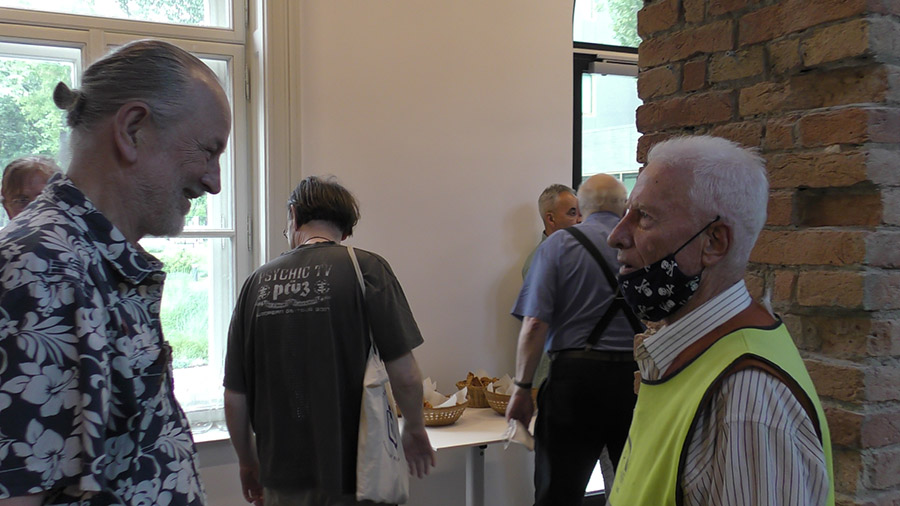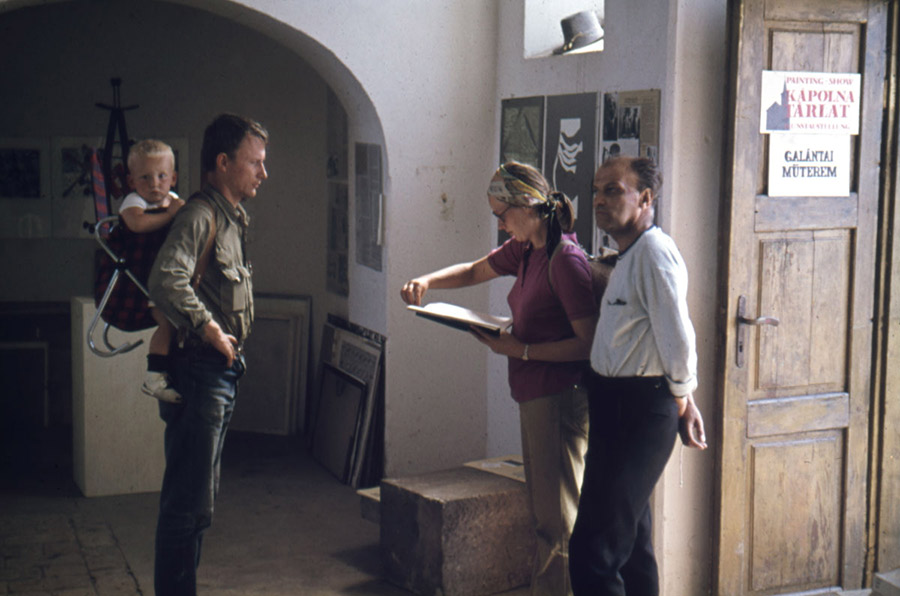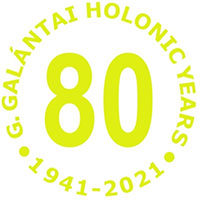Rudolf Ungváry (H)
A free man
“Where the years of smoke and mirrors corrupted you!
The colour of dreams and flames – the magical transition.”
(P. Rühmkorf: For a Headshot Moment)
I don’t know anyone else whose perspective is so unrestrained by conventions as his. It is as if he exuded a stylish nonchalance; from the first moment, his behaviour suggested trust, even though we had not had much to do with each other before then. He must have exuded this power without knowing, being unaware of it all...
He did not set conditions. He was refreshing and captivating. This was not expressed through words – although it did later – but rather through his being, posture and that friendly, carefree and curious look in his eyes. It was such an amazing gift in the communist era, under the boarded-up sky, where everything was about lies and coercion.
Obviously, it was the same world for him but he was far cleverer than me. He never directly resisted. He used clever – cunning, if you like – ‘distractions’. Like someone whose first inner response is hmm… And he grinned, visibly or rather invisibly. I met him before the Balatonboglár years, at Pál Petrigalla’s vinyl evenings, where a lot of people popped in in the sixties, as if it was a prelude to the underground scene that emerged in the seventies. It was a very special period in Hungarian art life, a kind of preliminary time in which nothing was able to mature but generations started going in the direction of breaking away from the prevailing, dictated reality. They were no middle-class generations because the middle-class was ultimately destroyed between 1945 and 1949. People were not openly rebelling either since that path was hopeless. The horizon was opening up for those who sought to create an inner alternative for themselves but since they were not looking for political answers, they expressed all this indirectly, metaphorically and embedded in aesthetic strivings. They created tiny spaces conceived in the intimate and restricted freedom of alternative gestures and abandon. Galántai was born to create such, and as I got to know him and realised this I too learnt how to live his kind of freedom because I badly wanted freedom. He was freer than me, no matter how much I too hated the system.
At the time it did not cross my mind that he and those around him were simply not interested in politics. What mattered to them was art and the autonomy of beauty and they were unwilling to mix politics with truth and morality. They were fundamentally right but for me it was all too simplified. I would dare to say that they were not really people of words and everything significant they had did not concern the truth and politics. Most of them managed to protect themselves from the temptations of power-thirstiness, inexorability and social bliss-making. Later, in a freer Hungary, some of them followed a path that took dreadful turns. All this time, in the sixties and seventies, everything was still deeply buried inside people; nobody paid much attention to it.
Even what was fermenting in the depth of those times to slowly surface was expressed indirectly: in its own, retarded Eastern and Central Eastern European way. Galántai was a born spiritus rector of this process. Then, when I had the chance to spend a longer time with him, in the wonderful, velvety warm and joyous summer of 1970, he had already been working on the chapel for a while to make it into a physical and geographical place of the freedom of the imagination. He was still at the beginning of what he built up in the end.
I will never forget those long conversations on the paved bank of the green-blue lake at Balatonboglár: they were carefree conversations yet contained the entire universe. There was hardly anyone around. The Balaton then was not what it has become now. It still preserved something of the simplicity and naturalness that it had in the sunken times of the interwar years.
His words sounded like the tiny ripples of the still water before us continuing into infinity. I was able to soak in the contemplative tranquillity in which we addressed our words to each other and at times, looking at the river, to the invisible world. It lasted a few days. It was a time filled with mysteries.
He regarded the chapel and its environs as magical and sacred. He had no rigid expectations in this regard. His thoughts about this were like humble, passing fancies. For me it was neither magical, nor sacred. At best all of existence was [magical and sacred] – if I wanted it so – in its incomprehensibility so I did not need a symbolic place where I can move this incomprehensibly greater-than-anything sensation. For me this place – the Chapel and its Immediate Environs – which he made into what it was, had up to then been merely a chapel spotted with trees, bushes and clearings, a place above the vineyards and the houses. Nothing more – and this palpable place was transformed through his creativity and powerful imagination into a space of free self-determination. It could only exist in our minds and in our souls – the place was only a medium. Unlike the place itself, free self-determination is sacred. Therefore, the environs of the chapel were indeed consecrated through the minds and souls of Galántai and the participants [of the Chapel events].
The exhibitions that were realised there took him by storm because he let them. It was his permissiveness that made them happen, or, if you like, created the opportunity for them to happen, so it was all thanks to him. The works that were conceived at these exhibitions and events were manifestations of art as life. As reality experienced. The impossible became an experience, like the word became incarnate. And, indeed, experiencing it all was the artwork itself, like some kind of total art. Gesamtkunst. It was also Galántai’s greatest work of art. Aesthetics and the thoughts along with it were manifest as life. In an age when every concept was mandatorily pervaded by the ideology and violence rooted in communism and socialism. In those years it was harder to detect what was going on than in the fifties. Everything was clad in the cloak of humanism and in the pretence of uplifting the weak; the smoke and clatter of the language that was used corrupted practically everybody. There was no escape: if you stayed in the country and, with disgust in your soul and with grinding teeth, could not – voluntarily or involuntarily – close yourself to what was happening, the only way out was the gestures of art, the magical transition it created. It was a forlorn yet wondrous time since all there was left for our souls was liberation through art. Those who had eyes to ‘see’ it and ears to ‘hear’ it, freed themselves from the constraints imposed upon the whole country.
In the invisible and free space that the chapel represented the concept of art was manifest through ideas: art rose out of thought. The kind of thought and way of thinking that Tamás Hencze described thus: “art is: what is art”. If you delve into this thought and follow it to its conclusion, you can rise above the world of constraints. The art actions in the chapel and in the open-air venues all expressed the same thing in a way: you must be able to see through reality to see the reality behind the smoke and mirrors.
I might be over the top here, as nothing is this perfect in real life but this is a pretty authentic picture of what I felt back then.
He [Galántai] was the grand master of breaking open with his sentences what seemed natural and obvious. In the political sphere of the time – because we were deep in it, art, aesthetics and self-abandon aside – we lived at least as much amidst restrictions and fatally as we do today. Galántai’s tactic was to plead insanity to the authorities whose power he was subjected to. He would always say to the representatives of the political regime that the given exhibition was artistic in nature and right afterwards he explained the aesthetic features of the exhibits using profound expressions: deep, fiery colours, the mystery of the world, forms and nature, the secret messages of beauty... and gestures, the creative act... “You understand, don’t you? This is the essence of it, and this is the space it requires. The space, you know, is magical…” You should have seen how the faces of the council’s dignitaries stiffened up; they were not used to such straightforward talk. They couldn’t afford to say they did not understand a word of this, while being terrified that this might bring about their demise somehow. This ignorance and helplessness temporarily spread to the period’s snot-headed art policy officials and executioners, until the point when they received the orders ‘from above’. Before that they had listened to Galántai’s passionate discussions on the aesthetics of art with an awkward grin on their faces.
This helped him to delay the inevitable. Counts for something. It was remarkable how he always wanted to – and still does today – slip out of politics but in fact what he was doing was incredibly ‘political’. He brought the omnipotence of political thinking into doubt, ultimately so. You can’t get more political than that. I believe that even today it would be a big deal if someone was able to realise a kind of ‘chapel exhibition’ – which would obviously be completely different from what it was then – that would cast doubt on the omnipotence of today’s idiotic and arrogantly self-absorbed politics. If someone was able to go so far that the agents of this system would be eventually unable to tolerate it. Galántai’s chapel exhibition and its entire milieu accomplished that. It was easy in an openly dictatorial system.
There is another thing in Galántai which I see as unique, since I am not able to have that same effect. Its his contrariness, his otherness that appeals to me. He is (and was back then too) protected by some kind of naivety from all harm. A lot of people didn’t understand him. Some thought that what he was doing was a suicide mission and some others, for example, sculptor Sándor Csutoros, assumed that “if he was able to go through with all this, he must have been an informer!” Coming up with such a broken, vile reaction to something that should have been seen as completely natural is almost impressive.
Ideas made the world of the chapel exhibitions into what it was. One of these ideas was expressed by Tamás Szentjóby when he said “Art is everything which is forbidden. Be forbidden!” How great it would be to state this to counter the prevailing ideology of today. “I know you are here reading, but you have no idea where I am” (Gyula Pauer). This meant something else back then than it does today, when such conceptual sentences can be serially manufactured by epigones. We should have sentences today that can have the same power that the ones quoted above had in their day. Coming up with sentences like those would certainly require great inner freedom.
I am grateful to fate that I was able to be a witness to the world of Balatonboglár.
The world of freedom.

György Galántai and Rudolf Ungváry at the "Galántai 80" event, 2021

1 September 1971 - Visit of Rudolf Ungváry and Pál Petrigalla at the chapel

● chapel ● Pál Petrigalla ● artists' stamp ●

openDemocracy ● TheGlobalDispatches

